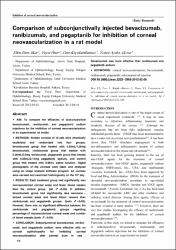Comparison of subconjunctivally injected bevacizumab, ranibizumab, and pegaptanib for inhibition of corneal neovascularization in a rat model
Citation
Akar, EE., Öner, V., Küçükerdönmez, C., Akova, YA. (2013). Comparison of subconjunctivally injected bevacizumab, ranibizumab, and pegaptanib for inhibition of corneal neovascularization in a rat model. International Journal of Ophthalmology, 6(2), 136-140.Abstract
AIM: To compare the efficacies of subconjunctival bevacizumab, ranibizumab, and pegaptanib sodium injections for the inhibition of corneal neovascularization in an experimental rat model. METHODS: Sixteen corneas of 16 rats were chemically cauterized and randomized into four groups: bevacizumab group that treated with 0.05mL/1.25mg bevacizumab, ranibizumab group that treated with 0.05mL/0.5mg ranibizumab, pegaptanib group that treated with 0.05mL/0.15mg pegaptanib sodium, and control group that treated with 0.05mL saline solution. Digital photographs of the corneas were taken and analyzed using an image analysis software program. All corneas were excised and examined histologically on the 15th day. RESULTS: Each treatment group had significantly less neovascularized corneal areas and fewer blood vessels than the control group (all P <0.05). in addition, bevacizumab group had significantly less neovascularized corneal areas and fewer blood vessels than ranibizumab and pegaptanib groups (both P <0.05). However, there was no significant difference between the ranibizumab and pegaptanib groups regarding percentage of neovascularized corneal areas and number of blood vessels (both P >0.05). CONCLUSION: Subconjunctival bevacizumab, ranibizumab, and pegaptanib sodium were effective with no corneal epitheliopathy for inhibiting corneal neovascularization after corneal burn in rats. Bevacizumab was more effective than ranibizumab and pegaptanib sodium.


















